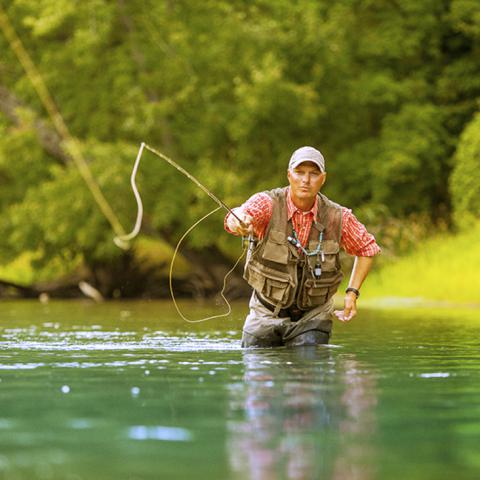Take up FLY-FISHING
 Fly fishing is an angling method in which an artificial "fly" is used to catch fish. The fly is cast using a fly rod, reel, and specialized weighted line. Casting a nearly weightless fly or "lure" requires casting techniques significantly different from other forms of casting. Fly fishermen use hand tied flies that resemble natural invertebrates or other food organisms, or "lures" to provoke the fish to strike.
Fly fishing is an angling method in which an artificial "fly" is used to catch fish. The fly is cast using a fly rod, reel, and specialized weighted line. Casting a nearly weightless fly or "lure" requires casting techniques significantly different from other forms of casting. Fly fishermen use hand tied flies that resemble natural invertebrates or other food organisms, or "lures" to provoke the fish to strike.Fly fishing can be done in fresh or salt water. North Americans usually distinguish freshwater fishing between cold-water species (trout, salmon, steelhead) and warm-water species, notably bass. In Britain, where natural water temperatures vary less, the distinction is between game fishing for trout or salmon and coarse fishing for other species. Techniques for fly fishing also differ with habitat (lakes and ponds, small streams, large rivers, bays and estuarys, and open ocean.)
TIPS FOR SPOTTING FISH:
1. Get a quality pair of polarized sunglasses. The right sunglasses are essential when trying to spot fish. Sun on the water causes a lot of glare, making it quite hard to spot fish. Polarized glasses removes that glare.
2. Fish midday. Fishing early and late when fish are more actively feeding increases your odds of catching them. However, for learning to spot fish - and thus better understanding their movements, preferred lies and feeding habits - the middle part of the day when the sun is high overhead gives you a better advantage. A high midday sun means there is little glare on the water, allowing you to more easily see into the river.
3. Approach the stream carefully. How you approach a stream is critical to your success. Always walk gently, never stomping your feet. Keep low, even squatting or crawling if the fish are spooky. Stay in the shade if possible. If you wade, go very slowly, keeping your ripples small and close to your feet.
4. Look for a fish's shadow on the streambed. Even the most experienced angler has difficulty spotting the actual fish holding in its lie - just ask any osprey. Millions of years of evolution have given trout an amazing ability to blend in with their watery surroundings, but there is a trick you can use: look for the fish's shadow.
The features that will create slower water ideal for attracting and holding fish are:
1. Boulders: Fish love boulders for the protection and feeding opportunities they provide. Boulders protruding from the water's surface create a pocket of slower water. The front pocket is formed by the damming effect on the current, causing the water to stack up and create a bulge of slower water. You will recognize this bulge and sometimes see a wave breaking just in front of it.
2. Stream Banks: First look for fish along the shore or banks of the river where the water is deep enough to hold fish or allow them to move into the shallows to feed. Particularly in the early morning, trout will move into surprisingly shallow "skinny water" to feed on nymphs or emerging insects. Look for active fish down stream from any irregular shoreline feature, bump or other protrusion you can see, such as a series of rocks jutting into water. Fish will hold in the slack current behind obstructions like these, so you can be confident they are there whether or not you see them feeding.
3. Fallen, Submerged Trees: Finding fish means first finding their habitat, and trees that have fallen or been swept into the river provide plenty of that. Whether still attached by roots or lodged against the bank or other structure, whole or partially submerged trees create a slack current attractive to fish (look for a slick water area or area of calmer water).
Source: redington.com, wikipedia.org